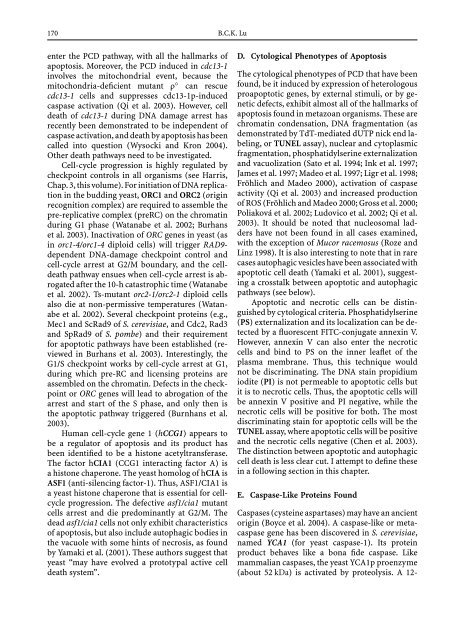Growth, Differentiation and Sexuality
Growth, Differentiation and Sexuality
Growth, Differentiation and Sexuality
You also want an ePaper? Increase the reach of your titles
YUMPU automatically turns print PDFs into web optimized ePapers that Google loves.
170 B.C.K. Lu<br />
enterthePCDpathway,withallthehallmarksof<br />
apoptosis. Moreover, the PCD induced in cdc13-1<br />
involves the mitochondrial event, because the<br />
mitochondria-deficient mutant Š ◦ can rescue<br />
cdc13-1 cells <strong>and</strong> suppresses cdc13-1p-induced<br />
caspase activation (Qi et al. 2003). However, cell<br />
death of cdc13-1 during DNA damage arrest has<br />
recently been demonstrated to be independent of<br />
caspase activation, <strong>and</strong> death by apoptosis has been<br />
called into question (Wysocki <strong>and</strong> Kron 2004).<br />
Other death pathways need to be investigated.<br />
Cell-cycle progression is highly regulated by<br />
checkpoint controls in all organisms (see Harris,<br />
Chap. 3, this volume). For initiation of DNA replication<br />
in the budding yeast, ORC1 <strong>and</strong> ORC2 (origin<br />
recognition complex) are required to assemble the<br />
pre-replicative complex (preRC) on the chromatin<br />
during G1 phase (Watanabe et al. 2002; Burhans<br />
et al. 2003). Inactivation of ORC genes in yeast (as<br />
in orc1-4/orc1-4 diploid cells) will trigger RAD9dependent<br />
DNA-damage checkpoint control <strong>and</strong><br />
cell-cycle arrest at G2/M boundary, <strong>and</strong> the celldeath<br />
pathway ensues when cell-cycle arrest is abrogatedafterthe10-hcatastrophictime(Watanabe<br />
et al. 2002). Ts-mutant orc2-1/orc2-1 diploid cells<br />
also die at non-permissive temperatures (Watanabe<br />
et al. 2002). Several checkpoint proteins (e.g.,<br />
Mec1 <strong>and</strong> ScRad9 of S. cerevisiae, <strong>and</strong> Cdc2, Rad3<br />
<strong>and</strong> SpRad9 of S. pombe) <strong>and</strong> their requirement<br />
for apoptotic pathways have been established (reviewed<br />
in Burhans et al. 2003). Interestingly, the<br />
G1/S checkpoint works by cell-cycle arrest at G1,<br />
during which pre-RC <strong>and</strong> licensing proteins are<br />
assembled on the chromatin. Defects in the checkpoint<br />
or ORC geneswillleadtoabrogationofthe<br />
arrest <strong>and</strong> start of the S phase, <strong>and</strong> only then is<br />
the apoptotic pathway triggered (Burnhans et al.<br />
2003).<br />
Human cell-cycle gene 1 (hCCG1) appears to<br />
be a regulator of apoptosis <strong>and</strong> its product has<br />
been identified to be a histone acetyltransferase.<br />
The factor hCIA1 (CCG1 interacting factor A) is<br />
a histone chaperone. The yeast homolog of hCIA is<br />
ASF1 (anti-silencing factor-1). Thus, ASF1/CIA1 is<br />
a yeast histone chaperone that is essential for cellcycle<br />
progression. The defective asf1/cia1 mutant<br />
cells arrest <strong>and</strong> die predominantly at G2/M. The<br />
dead asf1/cia1 cells not only exhibit characteristics<br />
of apoptosis, but also include autophagic bodies in<br />
the vacuole with some hints of necrosis, as found<br />
by Yamaki et al. (2001). These authors suggest that<br />
yeast “may have evolved a prototypal active cell<br />
death system”.<br />
D. Cytological Phenotypes of Apoptosis<br />
ThecytologicalphenotypesofPCDthathavebeen<br />
found, be it induced by expression of heterologous<br />
proapoptotic genes, by external stimuli, or by genetic<br />
defects, exhibit almost all of the hallmarks of<br />
apoptosis found in metazoan organisms. These are<br />
chromatin condensation, DNA fragmentation (as<br />
demonstrated by TdT-mediated dUTP nick end labeling,<br />
or TUNEL assay), nuclear <strong>and</strong> cytoplasmic<br />
fragmentation, phosphatidylserine externalization<br />
<strong>and</strong> vacuolization (Sato et al. 1994; Ink et al. 1997;<br />
James et al. 1997; Madeo et al. 1997; Ligr et al. 1998;<br />
Fröhlich <strong>and</strong> Madeo 2000), activation of caspase<br />
activity (Qi et al. 2003) <strong>and</strong> increased production<br />
of ROS (Fröhlich <strong>and</strong> Madeo 2000; Gross et al. 2000;<br />
Poliaková et al. 2002; Ludovico et al. 2002; Qi et al.<br />
2003). It should be noted that nucleosomal ladders<br />
have not been found in all cases examined,<br />
with the exception of Mucor racemosus (Roze <strong>and</strong><br />
Linz 1998). It is also interesting to note that in rare<br />
cases autophagic vesicles have been associated with<br />
apoptotic cell death (Yamaki et al. 2001), suggesting<br />
a crosstalk between apoptotic <strong>and</strong> autophagic<br />
pathways (see below).<br />
Apoptotic <strong>and</strong> necrotic cells can be distinguished<br />
by cytological criteria. Phosphatidylserine<br />
(PS) externalization <strong>and</strong> its localization can be detected<br />
by a fluorescent FITC-conjugate annexin V.<br />
However, annexin V can also enter the necrotic<br />
cells <strong>and</strong> bind to PS on the inner leaflet of the<br />
plasma membrane. Thus, this technique would<br />
not be discriminating. The DNA stain propidium<br />
iodite (PI) is not permeable to apoptotic cells but<br />
it is to necrotic cells. Thus, the apoptotic cells will<br />
be annexin V positive <strong>and</strong> PI negative, while the<br />
necroticcellswillbepositiveforboth.Themost<br />
discriminating stain for apoptotic cells will be the<br />
TUNEL assay, where apoptotic cells will be positive<br />
<strong>and</strong> the necrotic cells negative (Chen et al. 2003).<br />
The distinction between apoptotic <strong>and</strong> autophagic<br />
celldeathislessclearcut.Iattempttodefinethese<br />
in a following section in this chapter.<br />
E. Caspase-Like Proteins Found<br />
Caspases (cysteine aspartases) may have an ancient<br />
origin (Boyce et al. 2004). A caspase-like or metacaspase<br />
gene has been discovered in S. cerevisiae,<br />
named YCA1 (for yeast caspase-1). Its protein<br />
product behaves like a bona fide caspase. Like<br />
mammalian caspases, the yeast YCA1p proenzyme<br />
(about 52 kDa) is activated by proteolysis. A 12-

















